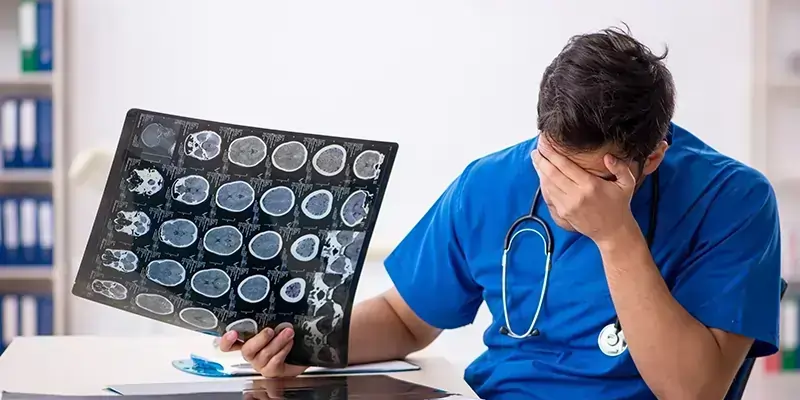

Teleradiology
10 Strategies To Prevent Burnout In Radiology
Radiology
Burnout has been a trending cause of concern amongst most professionals in the last decade. Radiologists are no exception to this risk. As per the Medscape National Physician Burnout and Depression Report of 2018, it was revealed that 42% of physicians were struggling with burnout. And according to the National Physician Burnout and Suicide Report 2020, radiologists have ranked among the top 5 specialties dealing with burnout. It has been observed that diagnostic radiologists are at a higher risk of burnout than the average physician.
According to recent studies, burnout has a major impact on radiologist life. As per ICD 11, "burnout" is a syndrome that results from chronic work that has not been completed. While it can cause exhaustion, emotional depletion, reduced efficiency, and feelings of cynicism towards radiology, mental turmoil also results in emotional detachment from the job. Hence, it is essential to diagnose early to avoid detachment and distress. Once depersonalization sets in, it is difficult to manage the issue with mitigation strategies alone.
Burnout causes a decrease in productivity, work absences, increased turnover, behavioural issues, conflicts, career dissatisfaction, and medical errors. When you are stressed at work and have increased burnout scores, it can lead to more perceived work medical errors and reduced work hours. Owing to the breakdown in communication amongst the team of healthcare providers resulting from burnout leads to a negative impact on patient safety.
Causes of Burnout
Long working hours and poor monetary remunerations, along with a lack of respect from patients and co-workers, resulted in a high-stress work environment. The need to deliver reports within a short turnaround time results in anxiety and stress. Since a sizeable portion of the radiologist’s work is done individually, they also tend to suffer from the most social isolation.
Dr. Namita at Aster Medical Imaging explains that, despite the challenge being real, it is upon us to balance the burnout in a healthy manner. Here are 10 strategies to prevent burnout in radiology.
Personal Level Strategies
-
Restoring a work-life balance
Maintaining a balance in your lifestyle and work life is a must to regulate physical and mental health. Ensure that you are emotionally happy while doing the job and mentally in a happy place. Long working hours result in reduced time spent with family and friends. This can make you feel resentful towards your job. The opportunity to form new relationships and the ability to form a significant support network reduces. Conquer work-related stress and reduce your work-life conflict by taking a proactive approach to ensure you spend adequate time with your loved ones. Spending time with loved ones is a great stress reliever. Intermittent breaks to rejuvenate and recharge help make you more productive and enable you to approach work more enthusiastically.
-
Practise mindfulness
Mindfulness is a well-known coping mechanism to reduce stress. It helps reduce stress, anxiety, depression, and distress. Start with breathing techniques, guided meditation, and releasing your tension to manage your work stress.
-
Seek therapy
In certain cases, you may require help from a mental health professional. Often, physicians are reluctant to seek therapy due to the stigma that comes along with it. However, you can combine your financial planning with peer support services to overcome this barrier. This reduces the stigma associated with reaching out for peer support.
Organisational Level Strategies
-
Educational resources
Most of the stress and feeling of burnout come from within due to the lack of confidence and communication skills. Educational strategies that help in improving the physician’s communication skills and boost their self-confidence can help relieve burnout. Individual and group interventions to discuss the issues at hand and then figure out solutions for the same are known to be more successful.
-
Open communication
Open communication between the staff and the organisation is essential. A routine monthly check-in to understand and discuss the issues helps monitor the progress and changes required. The organisation must examine the physicians, and their relationship with colleagues, and monitor their performance to understand the changes in productivity, job satisfaction, and safety.
-
Workflow autonomy
Having adequate staff specific for each task is necessary for sharing the workload. This enables the physician to afford greater job flexibility and ensure a better work-life balance. When the caseload increases, instead of making everyone work for longer hours, it’s easier to get into a rotational shift. Some radiologists can work extra hours and some can work weekend shifts. This can change every few hours or a few days to ensure the workload is divided. Overlapping the work shifts helps alleviate the workload while allowing the radiologists to maintain a good work-life balance. Working for longer hours on certain days of the week and shorter hours on other days helps complete the job without reducing total work effort.
-
Healthy work environment
When you are forced to work in a high-stress work environment, you are 15 times more likely to feel burnout. When a radiologist is newly starting their career, having a mentor to look up to, can help them manage their work in a better and more efficient manner. Having effective leaders around the juniors ensures that the strengths of the radiologists are put to the best possible use. The senior radiologist knows how to motivate younger colleagues and how to bring their talent out in the best way possible. Providing radiologists with an area of work that is best suited to their likes and talents enables them to feel more meaningful at work. Healthy discussions with colleagues about how to correct radiological diagnoses helped in managing various medical cases and boosts the confidence of the junior staff. Healthy discussions with colleagues and interaction with patients can help boost confidence.
-
Organisational Wellness Committee
Intermittent wellness surveys help identify burnout early on without letting it prevail for longer. The preventive steps in the right direction help reduce burnout and ensure a healthy working environment. Minor adjustments in work hours and workload can help in reducing burnout.
-
Social Deisolation
Instead of making the radiologists work in separate individual cubicles, it’s better to get them into a single reporting room. This enables increased interactions with other fellow physicians. Having multiple clinical radiologists beside you can help discuss certain cases and understand the different scenarios in the diagnosis of a condition.
-
Tech support
Providing tech support to radiologists is essential to reduce their workload. Providing advanced technological training helps radiologists be more efficient at their work. With the support of new EMR features, the radiologist needs to be focused on clinical reporting. Other admin-related tasks can be performed by non-clinicians.
Conclusion
Burnout is common among all professionals and often goes undiagnosed and unnoticed. We must take adequate measures to keep the mental and physical well-being of our healthcare professionals under check. Early interventions can help prevent burnout and promote overall health. Preventing burnout ensures high job satisfaction, optimal healthcare delivery, and positive outcomes.
More from AMI
Teleradiology's Contribution to Timely Emergency Diagnoses
04/10/2023
Cardiovascular Imaging: Expanding Access to Advanced Heart Care with Teleradiology
29/09/2025
Radiology Online Reporting: Transforming Diagnosis with Speed and Accuracy
31/07/2025
Scope of Radiologist in India
29/08/2023
Intra- Operative 3D Imaging With O- Arm Making Complex Spine Surgeries Safe and Accurate
30/11/2022
How Teleradiology Reporting Services Are Revolutionizing Frozen Shoulder Diagnosis and Reporting
17/11/2025
Imaging In Pregnancy
18/01/2023
Sports-Related Injuries and the Importance of Radiology
30/01/2023
Empowering Radiologists-Teleradiology Redefines the Role of Imaging Specialist
09/10/2023
Emerging Techniques in Radiology By Dr. Namita
10/11/2022
Unlocking the Knee: How Tele-Reporting Service Empowers Clinicians
25/11/2025
How Teleradiology Solutions Help Hospitals Cut Turnaround Time
20/08/2025
Radiology Practices
30/11/2022
How to Choose a Prospective Teleradiology Service Provider
07/08/2023
How to Increase the Efficiency of the Radiology Equipment
21/08/2023
Why Hospitals Prefer Teleradiology Outsourcing for Accurate and Timely MSK Injury Reports
14/11/2025
What is Diagnostic Radiology? Understanding its Tests and Procedures
14/08/2023
MRI Spine Thoracic: How Teleradiology Enhances Faster, Accurate Diagnosis
29/09/2025
How Teleradiology Supports Musculoskeletal Pain Specialists in Diagnosis
20/08/2025
Emerging Trends and Technologies in Medical Imaging
19/06/2023
Advances In Neuroradiology
06/01/2023
Behind The Scenes of Teleradiology: How Digital Imaging Is Changing Diagnostic Medicine
16/10/2023
Improvement of Patient Care Through Teleradiology
03/07/2023
Imaging Instrumentation Trends In Clinical Oncology
26/06/2023
How Aster Medical Imaging’s Nighthawk Service Enhances Brain Neuroimaging
29/09/2025
The Future of MRI: Advancements and AI Integration in Online MRI Reporting
19/05/2025
Revolutionizing Indian Healthcare: Unlocking the Potential of Teleradiology in Remote Areas
27/09/2023

AMI Expertise - When You Need It, Where You Need It.
Partner With Us
